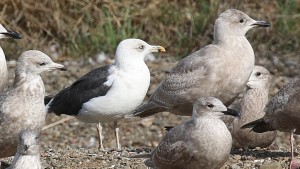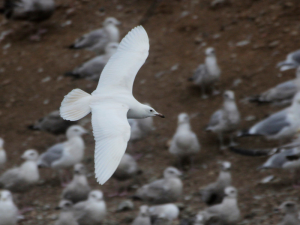
It could be said that Stockton’s David Yee is the pre-eminent pioneer of modern-day birding in the San Joaquin Valley. For well over thirty years, Yee has added record after record of unexpected bird sightings to our knowledge of bird distribution.
A few years ago, Yee found a gull in northwestern Stanislaus County that many birders thought was the first county record of a very rare Iceland Gull. A committee of highly qualified experts rejected the sighting, which included plenty of photographs. To this day, Yee and many others, also highly qualified, disagree with the committee.
Tuesday, Yee found yet another rare gull, most likely the second Stanislaus County record (Yee also found the first county record) of a European and Asian species called “Lesser Black-backed Gull.” The bird had some odd characteristics, and photographs Yee and others posted online set off a debate that garnered comments from experts around the state who finally have begun agreeing the bird is exactly what Yee said it was from the beginning: A Lesser Black-backed Gull.
Many people who enjoy birding decide that the enjoyment ends when trying to identify gulls, which can feature a bewildering array of plumages, bill and leg color, and even variations in eye color, mostly due to changes in appearances as the birds mature from juveniles to adults. Even some species of adult birds are strikingly similar to one another. Hard core birders like Yee, on the other hand, find the challenge of identifying these difficult individuals well worth the effort.

Over the last fifteen or twenty years, gull identification has gotten even more fraught with difficulty as human activity continues to add to the food supply for gulls, which are great scavengers. As the gulls forage farther and farther from their usual habitats, they find new niches and begin mating with other species. The result is hybrids showing characteristics of both species involved in the mating.
Given the multiple variations and identification problems posed by gulls, it’s no wonder many birders leave gull identification to the experts, who often disagree even among themselves. One thing most all birders agree upon, however, is that it’s always fun to see a new species, and Yee has provided other birders plenty of opportunities to see for themselves the out-of-range birds he continues to find so remarkably often.
Tuesday’s bird stayed around long enough to be seen both by several local birders and a couple of dedicated chasers from afar. Modesto’s Jim Gain, who has an almost uncanny knack for grabbing excellent photographs of difficult subjects, was on the spot when Tuesday’s bird reappeared Wednesday and shared some excellent shots. As for David Yee, he was already long gone and probably anticipating his next great find.
